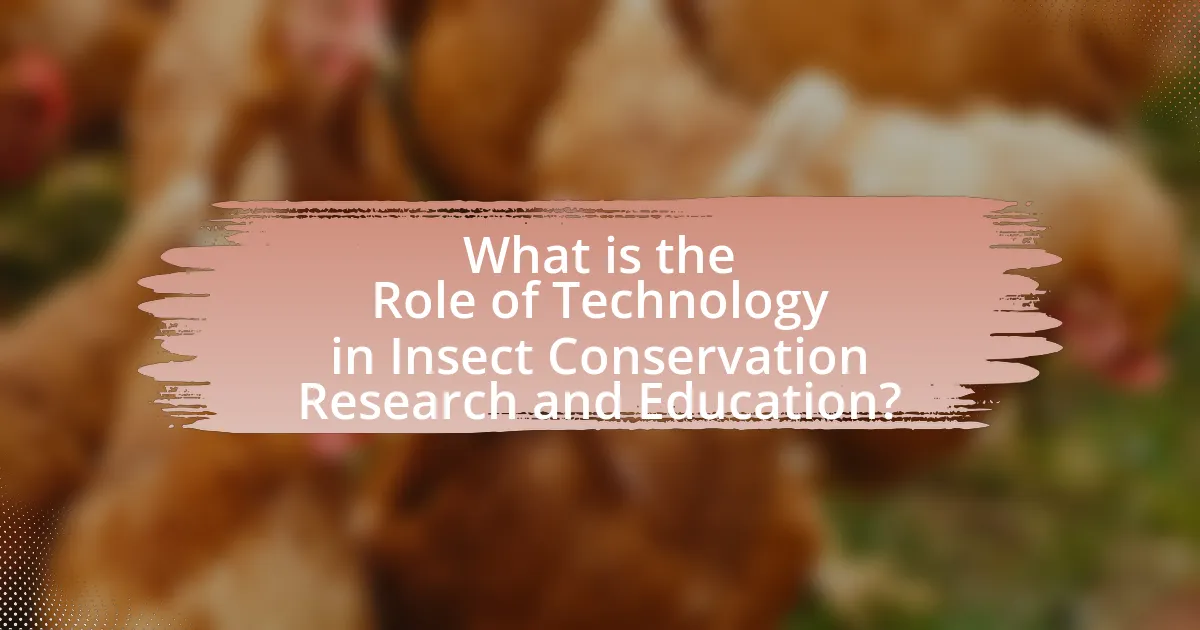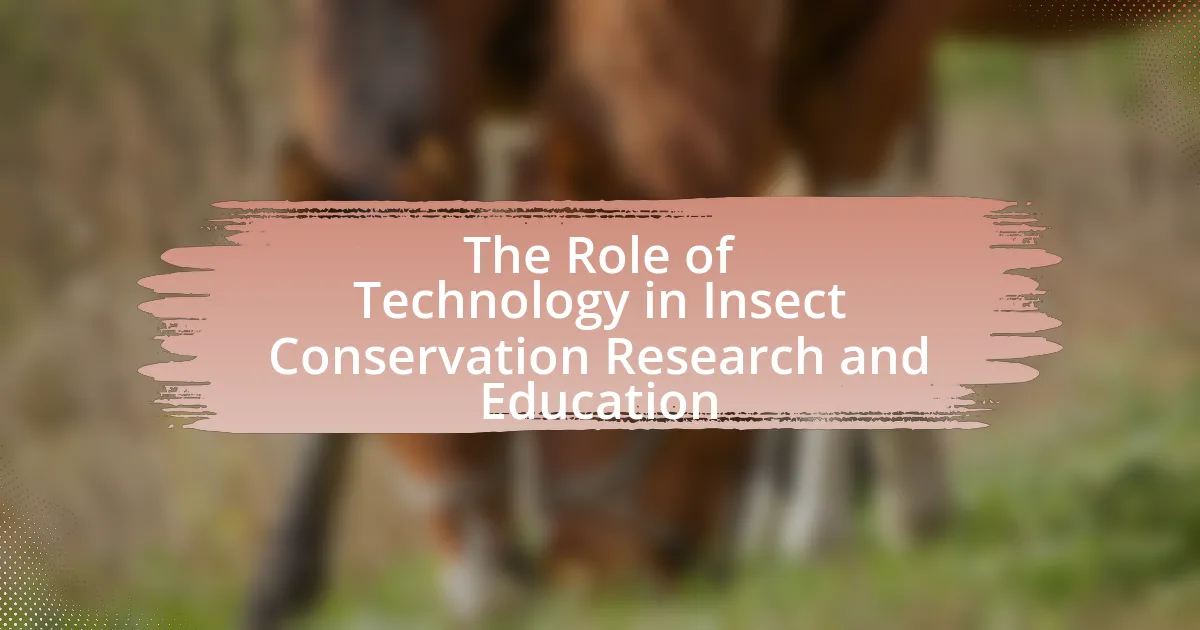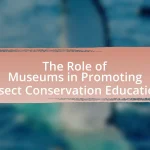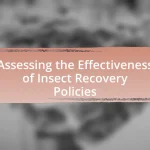The article examines the significant role of technology in insect conservation research and education, highlighting advancements such as remote sensing, genetic sequencing, and mobile applications. It discusses how these technologies enhance data collection, analysis, and public engagement, ultimately improving conservation strategies and outcomes. Key topics include the evolution of technology in this field, impactful advancements, challenges faced, and the importance of citizen science. The article also outlines best practices for integrating technology into conservation efforts and educational initiatives, emphasizing the need for interdisciplinary collaboration to address existing limitations.

What is the Role of Technology in Insect Conservation Research and Education?
Technology plays a crucial role in insect conservation research and education by enhancing data collection, analysis, and dissemination. For instance, remote sensing technologies allow researchers to monitor insect populations and habitats in real-time, providing critical insights into biodiversity and ecosystem health. Additionally, genetic sequencing technologies enable scientists to study the genetic diversity of insect species, which is essential for conservation efforts. Educational platforms, such as mobile applications and online databases, facilitate public engagement and awareness about insect conservation, making information accessible to a broader audience. These technological advancements are supported by studies indicating that effective use of technology can significantly improve conservation outcomes and public understanding of ecological issues.
How has technology evolved in the field of insect conservation?
Technology has significantly evolved in the field of insect conservation through advancements in data collection, analysis, and communication methods. Innovations such as remote sensing, environmental DNA (eDNA) analysis, and mobile applications have enhanced the ability to monitor insect populations and their habitats. For instance, eDNA techniques allow researchers to detect the presence of specific insect species in an environment by analyzing genetic material from soil or water samples, providing a non-invasive method for biodiversity assessment. Additionally, the use of drones for habitat mapping and monitoring has improved the efficiency and accuracy of data collection in hard-to-reach areas. These technological advancements have facilitated more effective conservation strategies and increased public engagement through educational platforms and citizen science initiatives, ultimately contributing to better-informed conservation efforts.
What technological advancements have been most impactful?
The most impactful technological advancements in insect conservation research and education include remote sensing, DNA barcoding, and mobile applications. Remote sensing technologies, such as satellite imagery and drones, enable researchers to monitor habitats and track insect populations over large areas, providing critical data for conservation efforts. DNA barcoding allows for precise species identification, facilitating the study of biodiversity and the detection of invasive species, which is essential for effective management strategies. Mobile applications enhance public engagement and citizen science by enabling users to report sightings and contribute to data collection, thereby increasing awareness and involvement in conservation initiatives. These advancements collectively improve the efficiency and effectiveness of insect conservation efforts.
How do these advancements enhance research methodologies?
Advancements in technology enhance research methodologies by enabling more precise data collection and analysis in insect conservation. For instance, the use of remote sensing technologies allows researchers to monitor insect populations and habitats in real-time, improving the accuracy of ecological assessments. Additionally, advancements in genetic sequencing technologies facilitate the study of biodiversity and species interactions, providing deeper insights into conservation needs. These methodologies are supported by data showing that remote sensing can increase monitoring efficiency by up to 50%, while genetic tools have been shown to reveal cryptic species that traditional methods might overlook.
Why is technology important for insect conservation education?
Technology is important for insect conservation education because it enhances data collection, analysis, and dissemination of information. For instance, tools like remote sensing and geographic information systems (GIS) allow researchers to monitor insect populations and habitats more effectively, leading to better-informed conservation strategies. Additionally, educational platforms and mobile applications facilitate the sharing of knowledge and resources, making it easier for the public to engage with and understand the importance of insect conservation. Studies have shown that interactive technology can increase awareness and participation in conservation efforts, thereby contributing to the overall success of insect preservation initiatives.
What educational tools are available for teaching about insect conservation?
Educational tools available for teaching about insect conservation include interactive apps, online courses, citizen science platforms, and educational kits. Interactive apps, such as iNaturalist, allow users to document and share insect sightings, fostering engagement and data collection. Online courses from platforms like Coursera and edX provide structured learning on biodiversity and conservation strategies. Citizen science platforms, such as BugGuide and Monarch Watch, enable participants to contribute to real-world research while learning about insect species and their habitats. Educational kits, like those from the National Wildlife Federation, offer hands-on activities that teach students about ecosystems and the importance of insects in maintaining ecological balance. These tools enhance understanding and promote active participation in insect conservation efforts.
How do these tools improve engagement and understanding?
These tools improve engagement and understanding by providing interactive and immersive experiences that facilitate learning about insect conservation. For instance, augmented reality applications allow users to visualize insects in their natural habitats, enhancing their connection to the subject matter. Research indicates that interactive learning environments can increase retention rates by up to 75%, compared to traditional methods. Additionally, data visualization tools present complex ecological data in accessible formats, making it easier for users to grasp critical concepts related to insect conservation. This combination of interactivity and clarity fosters a deeper appreciation and understanding of the importance of insects in ecosystems.
What challenges does technology face in insect conservation?
Technology faces several challenges in insect conservation, primarily including data collection limitations, habitat disruption, and the need for interdisciplinary collaboration. Data collection technologies, such as remote sensing and automated monitoring systems, often struggle with the vast diversity and elusive nature of insect species, leading to incomplete datasets. Habitat disruption occurs when technological interventions, like drone usage or habitat modification, inadvertently harm the very ecosystems they aim to protect. Furthermore, effective insect conservation requires collaboration across various fields, including ecology, technology, and policy, which can be hindered by differing priorities and communication barriers among stakeholders. These challenges highlight the complexities of integrating technology into insect conservation efforts effectively.
What are the limitations of current technological applications?
Current technological applications in insect conservation research and education face several limitations, including high costs, accessibility issues, and data reliability concerns. High costs can restrict the adoption of advanced technologies, such as drones and genetic sequencing tools, which may not be feasible for all research institutions or conservation organizations. Accessibility issues arise when technologies are not user-friendly or require specialized training, limiting their use among non-experts or in developing regions. Additionally, data reliability concerns stem from the potential for inaccuracies in automated data collection methods, such as image recognition software, which may misidentify species or fail to capture critical ecological interactions. These limitations hinder the effectiveness and widespread implementation of technological solutions in the field of insect conservation.
How can these challenges be addressed in future research?
Future research can address challenges in insect conservation by integrating advanced technologies such as remote sensing, artificial intelligence, and genetic analysis. These technologies enhance data collection and analysis, allowing for more accurate monitoring of insect populations and their habitats. For instance, remote sensing can provide large-scale environmental data, while AI algorithms can analyze patterns in insect behavior and distribution. Additionally, genetic analysis can help in understanding biodiversity and the genetic health of populations. Implementing these technologies can lead to more effective conservation strategies and educational outreach, as evidenced by studies showing improved outcomes in biodiversity assessments when utilizing such tools.
How does technology facilitate data collection in insect conservation?
Technology facilitates data collection in insect conservation by enabling precise monitoring, data analysis, and efficient communication. Tools such as remote sensing, GPS tracking, and automated traps allow researchers to gather large volumes of data on insect populations and behaviors in real-time. For instance, the use of camera traps equipped with motion sensors can capture images of insects in their natural habitats, providing valuable insights into their distribution and activity patterns. Additionally, mobile applications and databases streamline data entry and sharing among researchers, enhancing collaboration and accelerating the analysis process. Studies have shown that these technological advancements significantly improve the accuracy and efficiency of data collection, leading to more informed conservation strategies.
What methods are used for data collection through technology?
Data collection through technology in insect conservation research and education primarily utilizes methods such as remote sensing, automated data loggers, and mobile applications. Remote sensing employs satellite imagery and drones to monitor habitats and track insect populations over large areas, providing real-time data on environmental changes. Automated data loggers record environmental parameters like temperature and humidity, which are crucial for understanding insect behavior and ecology. Mobile applications facilitate citizen science by allowing users to report insect sightings and contribute to databases, enhancing community engagement and data richness. These methods collectively enhance the accuracy and efficiency of data collection in the field of insect conservation.
How does data analysis improve conservation strategies?
Data analysis improves conservation strategies by enabling the identification of trends and patterns in biodiversity and ecosystem health. By analyzing large datasets, researchers can assess species populations, habitat conditions, and threats, leading to informed decision-making. For instance, a study published in “Ecological Applications” by McCarthy et al. (2017) demonstrated that data-driven models can predict the impacts of climate change on insect populations, allowing conservationists to prioritize areas for protection. This targeted approach enhances resource allocation and increases the effectiveness of conservation efforts.
What role does citizen science play in insect conservation through technology?
Citizen science plays a crucial role in insect conservation through technology by enabling non-experts to collect and analyze data on insect populations and behaviors. This participatory approach leverages mobile apps and online platforms, allowing individuals to report sightings, contribute to biodiversity databases, and engage in monitoring efforts. For instance, projects like iNaturalist and eBird utilize technology to facilitate data collection, which has led to significant contributions in understanding species distribution and population trends. Research indicates that citizen-generated data can be as reliable as that collected by professionals, enhancing the overall effectiveness of conservation strategies.
How can technology empower citizen scientists?
Technology empowers citizen scientists by providing accessible tools and platforms for data collection, analysis, and sharing. For instance, mobile applications enable individuals to document insect sightings and contribute to biodiversity databases, such as iNaturalist, which has recorded over 30 million observations since its launch. Additionally, online platforms facilitate collaboration among citizen scientists and researchers, enhancing the quality and scope of conservation efforts. These technological advancements not only democratize scientific research but also foster community engagement and awareness in insect conservation.
What platforms are available for citizen engagement in insect conservation?
Platforms available for citizen engagement in insect conservation include mobile applications, online databases, social media, and citizen science projects. Mobile applications like iNaturalist allow users to document and share insect sightings, contributing to biodiversity databases. Online databases such as BugGuide provide a platform for identification and information sharing among enthusiasts and researchers. Social media platforms facilitate community engagement and awareness campaigns, while citizen science projects like Monarch Watch enable individuals to participate in data collection and monitoring efforts. These platforms collectively enhance public involvement and contribute valuable data to conservation efforts.
What are the best practices for integrating technology into insect conservation efforts?
The best practices for integrating technology into insect conservation efforts include utilizing data collection tools, employing remote sensing technologies, and leveraging citizen science platforms. Data collection tools, such as mobile applications and automated traps, enable researchers to gather real-time data on insect populations and behaviors, enhancing monitoring efforts. Remote sensing technologies, like drones and satellite imagery, provide valuable insights into habitat changes and landscape dynamics affecting insect habitats. Additionally, citizen science platforms engage the public in data collection, increasing the volume of information available for analysis and fostering community involvement in conservation initiatives. These practices have been shown to improve the effectiveness of conservation strategies and enhance public awareness of insect biodiversity.
How can researchers effectively utilize technology in their studies?
Researchers can effectively utilize technology in their studies by employing advanced data collection tools, such as remote sensing and drones, to gather real-time ecological data. These technologies enable researchers to monitor insect populations and habitats with high precision and efficiency. For instance, a study published in the journal “Ecological Applications” demonstrated that drones could accurately map vegetation and assess habitat quality, which is crucial for understanding insect conservation needs. Additionally, researchers can use data analysis software and machine learning algorithms to process large datasets, allowing for more robust statistical analyses and predictive modeling of insect behavior and population dynamics. This integration of technology not only enhances the accuracy of research findings but also facilitates more informed conservation strategies.
What tips can educators follow to incorporate technology in teaching about insects?
Educators can incorporate technology in teaching about insects by utilizing interactive digital platforms, such as virtual labs and simulation software, to enhance student engagement and understanding. These tools allow students to explore insect anatomy, behavior, and ecosystems in a dynamic way, fostering a deeper appreciation for biodiversity. For instance, using apps like iNaturalist enables students to document and identify local insect species, promoting citizen science and real-world application of their learning. Additionally, integrating multimedia resources, such as videos and interactive presentations, can provide visual context and stimulate interest in insect conservation topics. Research indicates that technology-enhanced learning environments can improve student outcomes and retention of information, making these methods effective in insect education.


